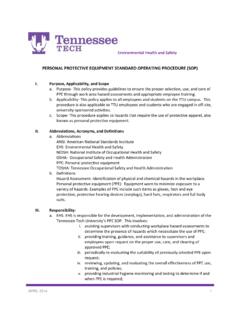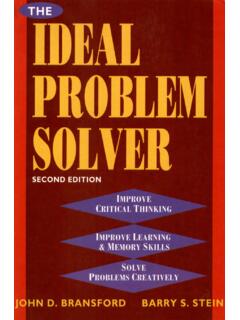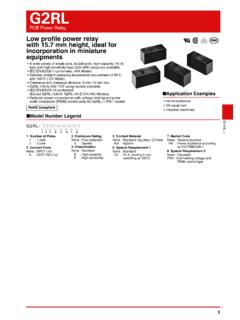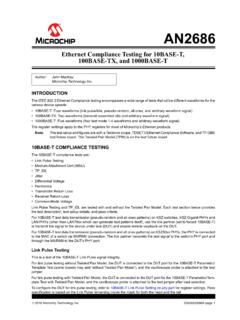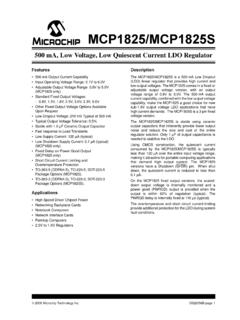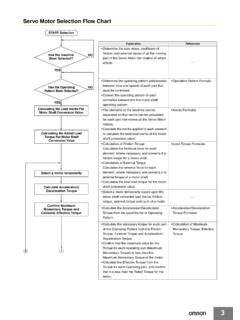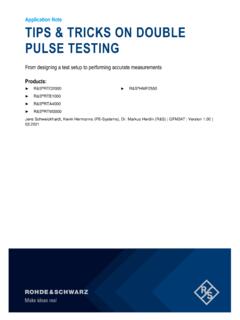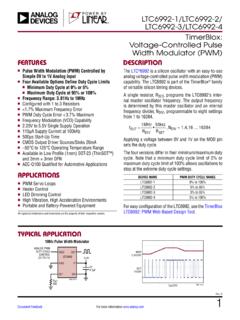Transcription of CHAPTER 2 SINGLE PHASE PULSE WIDTH MODULATED …
1 CHAPTER 2 SINGLE PHASE PULSE WIDTH MODULATED INVERTERS Introduction The dc-ac converter, also known as the inverter, converts dc power to ac power at desired output voltage and frequency. The dc power input to the inverter is obtained from an existing power supply network or from a rotating alternator through a rectifier or a battery, fuel cell, photovoltaic array or magneto hydrodynamic generator. The filter capacitor across the input terminals of the inverter provides a constant dc link voltage. The inverter therefore is an adjustable-frequency voltage source. The configuration of ac to dc converter and dc to ac inverter is called a dc-link converter. Inverters can be broadly classified into two types, voltage source and current source inverters. A voltage fed inverter (VFI) or more generally a voltage source inverter (VSI) is one in which the dc source has small or negligible impedance.
2 The voltage at the input terminals is constant. A current source inverter (CSI) is fed with adjustable current from the dc source of high impedance that is from a constant dc source. A voltage source inverter employing thyristors as switches, some type of forced commutation is required, while the VSIs made up of using GTOs, power transistors, power MOSFETs or IGBTs, self commutation with base or gate drive signals for their controlled turn-on and turn-off. 16 A standard SINGLE - PHASE voltage or current source inverter can be in the half-bridge or full-bridge configuration. The SINGLE - PHASE units can be joined to have three- PHASE or multiphase topologies. Some industrial applications of inverters are for adjustable-speed ac drives, induction heating, standby aircraft power supplies, UPS (uninterruptible power supplies) for computers, HVDC transmission lines, etc.
3 In this CHAPTER SINGLE - PHASE inverters and their operating principles are analyzed in detail. The concept of PULSE WIDTH Modulation (PWM) for inverters is described with analyses extended to different kinds of PWM strategies. Finally the simulation results for a SINGLE - PHASE inverter using the PWM strategies described are presented. Voltage Control in SINGLE - PHASE Inverters The schematic of inverter system is as shown in Figure , in which the battery or rectifier provides the dc supply to the inverter. The inverter is used to control the fundamental voltage magnitude and the frequency of the ac output voltage. AC loads may require constant or adjustable voltage at their input terminals, when such loads are fed by inverters, it is essential that the output voltage of the inverters is so controlled as to fulfill the requirement of the loads.
4 For example if the inverter supplies power to a magnetic circuit, such as a induction motor, the voltage to frequency ratio at the inverter output terminals must be kept constant. This avoids saturation in the magnetic circuit of the device fed by the inverter. 17 BatteryorRectifierInverterdVdCACV oltage Figure : Schematic for Inverter System The various methods for the control of output voltage of inverters can be classified as: (a) External control of ac output voltage (b) External control of dc input voltage (c ) Internal control of the inverter. The first two methods require the use of peripheral components whereas the third method requires no external components. Mostly the internal control of the inverters is dealt, and so the third method of control is discussed in great detail in the following section.
5 PULSE WIDTH Modulation Control The fundamental magnitude of the output voltage from an inverter can be controlled to be constant by exercising control within the inverter itself that is no external control circuitry is required. The most efficient method of doing this is by PULSE WIDTH Modulation (PWM) control used within the inverter. In this scheme the inverter is fed by a fixed input voltage and a controlled ac voltage is obtained by 18adjusting the on and the off periods of the inverter components. The advantages of the PWM control scheme are [10]: a) The output voltage control can be obtained without addition of any external components. b) PWM minimizes the lower order harmonics, while the higher order harmonics can be eliminated using a filter.
6 The disadvantage possessed by this scheme is that the switching devices used in the inverter are expensive as they must possess low turn on and turn off times, nevertheless PWM operated are very popular in all industrial equipments. PWM techniques are characterized by constant amplitude pulses with different duty cycles for each period. The WIDTH of these pulses are MODULATED to obtain inverter output voltage control and to reduce its harmonic content. There are different PWM techniques which essentially differ in the harmonic content of their respective output voltages, thus the choice of a particular PWM technique depends on the permissible harmonic content in the inverter output voltage. Sinusoidal- PULSE WIDTH Modulation (SPWM) The sinusoidal PWM (SPWM) method also known as the triangulation, sub harmonic, or suboscillation method, is very popular in industrial applications and is extensively reviewed in the literature [1-2].
7 The SPWM is explained with reference to Figure , which is the half-bridge circuit topology for a SINGLE - PHASE inverter. 19S11S12dV2dV2dV++CCoV Figure : Schematic diagram for Half-Bridge PWM inverter. For realizing SPWM, a high-frequency triangular carrier wave is compared with a sinusoidal reference of the desired frequency. The intersection of and waves determines the switching instants and commutation of the MODULATED PULSE . The PWM scheme is illustrated in Figure a, in which vis the peak value of triangular carrier wave and vthat of the reference, or modulating signal. The figure shows the triangle and modulation signal with some arbitrary frequency and magnitude. In the inverter of Figure the switches and are controlled based on the comparison of control signal and the triangular wave which are mixed in a comparator.
8 When sinusoidal wave has magnitude higher than the triangular wave the comparator output is high, otherwise it is low. cvrvcvrvc12r11SS v> is on , rcv11S2doutV=V ( ) and < is on , rvcv12S2doutV =V ( ) 20 (a) (b) Figure : SPWM illustration (a) Sine-Triangle Comparison (b) Switching Pulses after comparison. 21 The comparator output is processesed in a trigger PULSE generator in such a manner that the output voltage wave of the inverter has a PULSE WIDTH in agreement with the comparator output PULSE WIDTH . The magnitude ratio of crvvis called the modulation index () and it controls the harmonic content of the output voltage waveform.
9 The magnitude of fundamental component of output voltage is proportional to . The amplitude of the triangular wave is generally kept constant. The frequency modulation ratio is defined as imimcvfm mtfffm= ( ) To satisfy the Kirchoff s Voltage law (KVL) constraint, the switches on the same leg are not turned on at the same time, which gives the condition + = 1 ( ) 11S12 Sfor each leg of the inverter. This enables the output voltage to fluctuate between 2dVand 2dV as shown in Figure for a dc voltage of 200 V. 22 Figure : Output voltage of the Half-Bridge inverter.
10 SINGLE - PHASE Inverters A SINGLE - PHASE inverter in the full bridge topology is as shown in Figure , which consists of four switching devices, two of them on each leg. The full-bridge inverter can produce an output power twice that of the half-bridge inverter with the same input voltage. Three different PWM switching schemes are discussed in this section, which improve the characteristics of the inverter. The objective is to add a zero sequence voltage to the modulation signals in such a way to ensure the clamping of the devices to either the positive or negative dc rail; in the process of which the voltage gain is improved, leading to an increased load fundamental voltage, reduction in total current distortion and increased load power factor.

